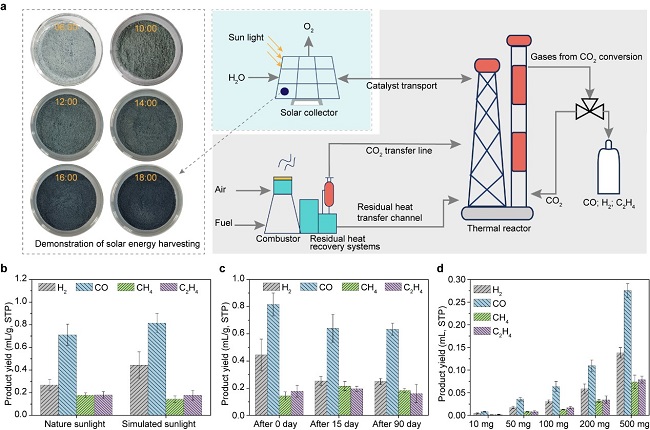Developing efficient methods to reduce pollution and carbon emissions is a key scientific focus for achieving sustainable development. Natural photosynthesis decouples the light absorption and CO2 reduction processes, offering new insights into the utilization of intermittent solar energy. The low energy density and intermittent supply of solar energy pose significant challenges for achieving controllable and efficient CO2 conversion. Thus, integrating intermittent sunlight with residual heat to enable controllable and efficient CO2 conversion is of both significant scientific and practical importance.
The Air Purification New Technology team (AirPNT) from the Institute of Earth Environment of the Chinese Academy of Sciences, in collaboration with various domestic teams, has proposed an innovative approach for CO2 utilization by collecting hydrogen atoms and electrons through solar energy, successfully overcoming the limitations of intermittent solar supply. This method, inspired by natural photosynthesis, involves storing electrons and hydrogen atoms in catalysts via sunlight and water (Fig. 1). The stored electrons and hydrogen atoms can be released under heating conditions to reduce CO2 at low temperatures, enabling on-demand CO2 conversion. In proof-of-concept experiments, Cu-loaded WO3 catalysts (Cu/WO3) were employed. Under illumination, photocatalytic water splitting generated hydrogen atoms and electrons, which were subsequently stored in Cu/WO3, forming a metastable intermediate (Cu/HxWO3). Heating Cu/HxWO3 at low temperatures (150–300°C) subsequently activated the release of stored electrons and hydrogen atoms, enabling CO2 reduction. The experiments further demonstrated the practical feasibility of utilizing natural sunlight to drive the process (Fig. 2), thereby opening an avenue for harnessing intermittent solar energy for CO2 utilization.
This achievement builds upon the team's recent strategic research and accumulation of results in developing reproducible and easily promotable pollution reduction and carbon reduction technologies. It will significantly advance the scientific and industrial development of green energy-driven deep CO2 conversion technologies.
The research published on Nature Communications, was jointly funded by the Strategic Priority Research Program of the Chinese Academy of Sciences, the National Natural Science Foundation of China, and the Youth Cross-Team Scientific Research Project of the Chinese Academy of Sciences.

Fig. 1 Diagram illustrating the integration of intermittent sunlight and residual heat for on-demand CO2 conversion with water. (Image by Shi, et al)

Fig. 2 Demonstration of utilizing natural light for on-demand CO2 conversion. (Image by Shi, et al)
 © 2015 Institute of Earth Environment,CAS
© 2015 Institute of Earth Environment,CAS Address:No. 97 Yanxiang Road, Xi'an 710061, Shaanxi, China

 Location :
Location :